Abstract
Expressionism
Abstract Expressionism is an
American modern art movement. It was also known as the New York
School, the New American Painting, Action Painting and
American-Type painting. This art movement, which primarily
manifested through painting, was centered in New York City at the
end of the 1940s and continued through the 1950s. Though there
are still artists today producing forms of abstract expressionist
art. Abstract Expressionist works are categorized as American but
the movement was initiated by the work of refugee European
Surrealists. Abstract Expressionist artists were strongly
influenced by Surrealist art and ideals. Though they rejected
realism and the illusions that characterized Surrealist art, they
borrowed the idea of art as a vehicle for emotional expression,
an 'exploitation of the subconscious'.
Though there are several mediums
such as film and sculpture that can be classified as Abstract
Expressionist works, paintings embody the style and ideals. David
Shapiro and Cecile Shapiro write that Abstract Expressionist
paintings "...dispensed with recognizable images from the
known world. Its surfaces were often rough, unfinished, even
sloppy, with uneven textures and dripping paint. Violent, brutal,
impoverished, slapdash, it demanded attention yet offered no clue
to the nature of the response expected. It had force, energy,
mystery, yet its explosions seemed inchoate outpourings of
expression to which viewers were provided no key." (p. 1)
One of the main characteristics of
Abstract Expressionist art is the use of colour and the
variations on how colours should be presented. There was a focus
on bold and bright colours in some works and an equally effective
trend towards murky and organic tones. Jackson Pollock favoured a
painting technique that involved dripping colors over large
canvases to create energetic, random patterns. Other artists,
such as Mark Rothko whose works are described in later sections,
developed 'color-field' painting. This involved applying large
bands or muted shapes of subtly modulated color to the canvas.
His paintings can easily be described as 'formless, lineless
patches of colour'.
Many of the colourful works
involved techniques employing accident. This leads to another
defining characteristic of Abstract Expressionism. The artistic
and creative process makes itself seen to the viewer. It is easy
to see the type of utensil used to apply the paint and the shapes
and layers define the steps that contributed to the development
of the artwork. Many artists also manipulated and abstracted
organic shapes and forms to create patterns and strong visual
effects.
Willem de Kooning
Willem de Kooning was perhaps the
best known and most influential Abstract Expressionists. As shown
in Gotham News, nicknamed after New York City, his most
significant achievement was "the synthesis of figuration and
abstraction, combined with an aggressive, gestural brushstroke
that gave his paintings a rich surface texture and vibrant
energy." This painting is abstract because it does not
resemble the real world. It is expressionist, because the
emotional and subjective aspects of the painting are more
important than objective and formal aspects. The colors, crowds,
and energy are a subjective view of his home. There are no
obvious forms of skyscrapers and yellow taxis in the painting.
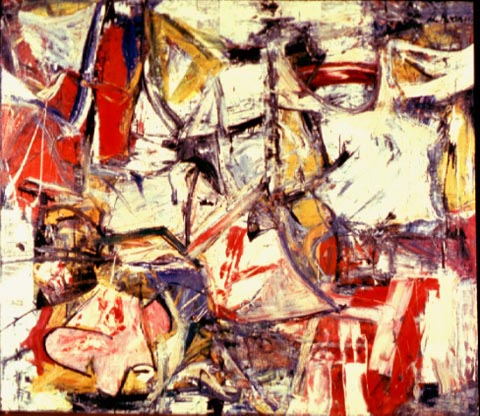 |
The process in which this
painting was created is evident in the prints that fades
towards the left hand side corners of the painting. De
Kooning had been using newspaper to help the paint to
dry, and in that process some of the print came off. De
Kooning's technique used to create Gotham News has
been labeled "action" or "gesture"
painting, referring to the fact that the artist’s
movements and creation process are clearly evident in the
final result. One critics writes that "De Kooning
used a number of different sized brushes—some
strokes are very wide and others are quite thin. The
paint is applied in a variety of ways as well, from very
thin passages to thick areas of paint squeezed directly
from the tubes. Although it appears as if Gotham News was
painted quickly and spontaneously, de Kooning actually
thought carefully about
the creation process, often stepping back to consider his
next move. The role of accident was important as well, as
seen in the unintended newsprint and the way in which the
paint was allowed to run in a number of areas."
Gotham News, 1955
oil on canvas, 69 x
79"
|
Mark Rothko
|
Red, Orange, Tan and Purple - Mark
Rothko
| Much
of Mark Rothko's art is identified by stacks of colored,
soft-edged rectangles that float on the canvas. An art
critic wrote that "their colors suggest an infinite
number of associations to the natural world in which we
are constituent creatures". His style was to paint
hazy, 'pulsating' shapes in a vertical or horizontal
format. He explained that these shapes ‘have no
direct association with any particular visible
experience, but in them one recognises the principle and
passion of organisms’. He was also quoted saying
"Every shape becomes an organic entity, inviting the
multiplicity of associations inherent in all living
things". The focus on colour and the use of organic
forms are characteristic of Abstract Expressionism. Red, Orange, Tan and Purple - Mark
Rothko
http://img9.webshots.com/photos41/306/42/3064219WDtyKxKitz_photo.jpg
|
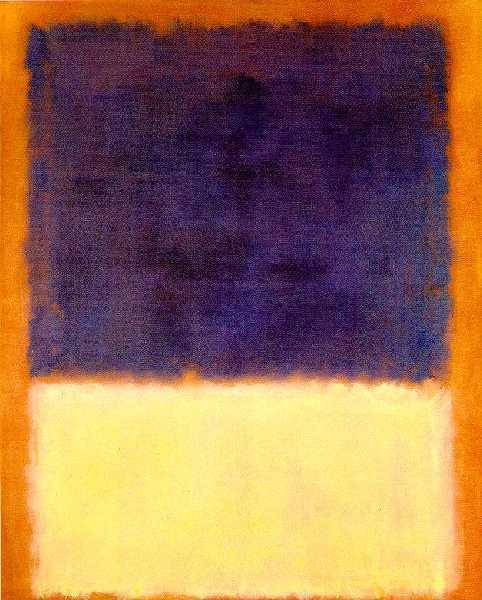 |
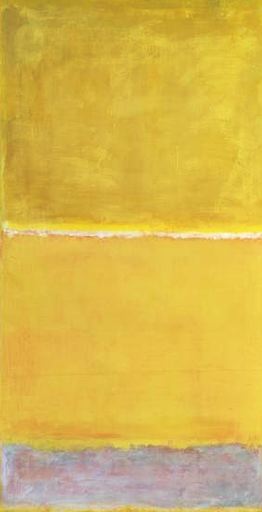 |
Untitled
circa 1951-2 Oil on
canvas (Oc)
Rothko was said to have
"scaled his pictures so that the viewer is enveloped
in their luminous, atmospheric surface." The
vertically stacked blocks of colour visually relate to
the use of horizon lines and his choice of colours are
earthy and organic. The colours themselves are uneven
which add a textural quality to the painting and forces
the viewer to look into the painting. The process of
creating this piece is apparent through the obvious
layering of paing and the marks intentionally left by the
instruments Rothko used.
|
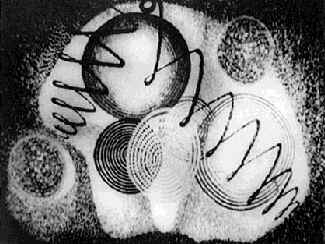 Oskar Fischinger Motion Painting
No. 1
|
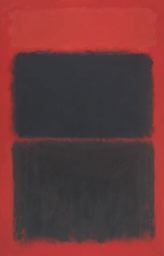 Mark Rothko Light Red over Black
|
Fischinger's film and Rothko's
painting have many similarities. This painting is similar to Motion
Painting No. 1 in that they were both created by the layering
of colour on top of colour. Rothko's work seems as though he
created one painting and then started to paint on top of it with
the red, or with the black, depending on how you see the
painting. The painting itself gives the viewer the ability to see
the layers and the marks left by the instruments used to create
the painting. This aspect of the creative process behind a
painting is characteristic Abstract Expressionist works and is
much more evident in Fischinger's film. Motion Painting No. 1
documents the growth of a specific painting. Fischinger’s
film uses well-defined, brightly colored geometric images and was
painted as an experimental work, in order to reveal the
"process by which a painting develops".
The two works are also similar in
their connection to organic influences. Rothko's soft, floating
shapes seem natural and almost human. Fischinger used
organic-influenced shapes such as spirals similar to those on
shells and snails. The works relate to the real world, without
overtly representing structures and realistic images.
The two artistic works also have
differences. The most obvious difference is the choice of colour
tone. Fischinger used alot of pale and natural colours, though at
the climax of the film, the colours become more bold. Rothko use
black and red, and though the shapes themselves are softened, the
colours are strong and vibrant. Fischinger is also much more
mathematical and precise, whereas Rothko prefers blurred forms
and bands.
References and Resources
http://www.artchive.com/artchive/D/de_kooning.html
http://www.albrightknox.org/ArtStart/Kooning.htm
http://www.artchive.com/artchive/R/rothko.html
http://img9.webshots.com/photos41/306/42/3064219WDtyKxKitz_photo.jpg
http://www.tate.org.uk/servlet/AWork?id=12569
http://www.metroactive.com/papers/metro/02.22.96/art-books-9608.html
http://artscenecal.com/ArticlesFile/Archive/Articles1998/Articles0498/OFischingerA.html
http://www.filmkultura.iif.hu:8080/2000/articles/profiles/images/avant/avant2.jpg
Shapiro, David and Cecile. Abstract Expressionism: A Critical
Record. Cambridge University Press, 1990.




